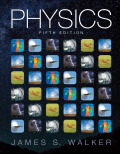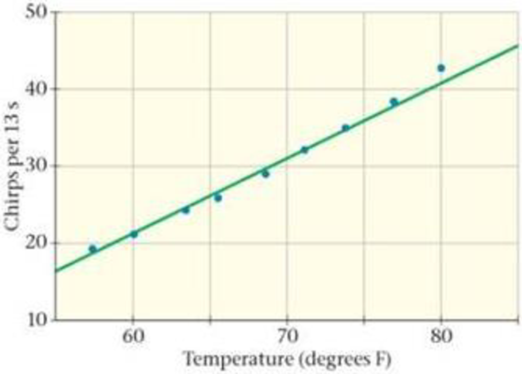
Concept explainers
BIO A Cricket Thermometer, by Jiminy
Insects are ectothermic, which means their body temperature is largely determined by the temperature of their surroundings. This can have a number of interesting consequences. For example, the wing coloration in some butterfly species is determined by the ambient temperature, as is the body color of several species of dragonfly. In addition, the wing beat frequency of beetles taking flight varies with temperature due to changes in the resonant frequency of their thorax.
The origin of such temperature effects can be traced back to the fact that molecules have higher speeds and greater energy as temperature is increased (see Chapters 16 and 17). Thus, for example, molecules that collide and react as part of the
One of the most interesting thermal effects is the temperature dependence of chirp rate in certain insects. This behavior has been observed in cone-headed grasshoppers, as well as several types of cricket. A particularly accurate connection between chirp rate and temperature is found in the snowy tree cricket (Oecanthus fultoni Walker), which chirps at a rate that follows the expression N = T − 39, where N is the number of chirps in 13 seconds, and T is the numerical value of the temperature in degrees Fahrenheit. This formula, which is known as Dolbear’s law, is plotted in Figure 13-46 (green line) along with data points (blue dots) for the snowy tree cricket.

Figure 13-46 Problems 93, 94, 95, and 96
94. • What is the temperature in degrees Fahrenheit if a cricket is observed to give 35 chirps in 13 s?
- A. 13 °F
- B. 35 °F
- C. 74 °F
- D. 90 °F
Want to see the full answer?
Check out a sample textbook solution
Chapter 13 Solutions
Physics (5th Edition)
Additional Science Textbook Solutions
Chemistry: An Introduction to General, Organic, and Biological Chemistry (13th Edition)
Campbell Biology (11th Edition)
Human Biology: Concepts and Current Issues (8th Edition)
Campbell Biology in Focus (2nd Edition)
Biology: Life on Earth (11th Edition)
Microbiology: An Introduction
- A 1.10 x 10²-g particle is released from rest at point A on the inside of a smooth hemispherical bowl of radius R R B 2R/3 (a) Calculate its gravitational potential energy at A relative to B. ] (b) Calculate its kinetic energy at B. ] (c) Calculate its speed at B. m/s (d) Calculate its potential energy at C relative to B. J (e) Calculate its kinetic energy at C. ] = 26.5 cm (figure below).arrow_forwardReport on the percentage errors (with uncertainty) between the value of 'k' from the F vs displacement plot and each of the values of 'k' from the period measurements. Please comment on the goodness of the results. Value of k = Spring constant k = 50.00 N/m Each of the values of k from period measurements: Six Measurements of time for 5 osccilations: t1 = 7.76s, t2=8.00s, t3=7.40s, t4=7.00s, t5=6.90s, t6=7.10s (t1-tavg)^2 = (7.76-7.36)^2 = 0.16%(t2-tavg)^2 =(8.00-7.36)^2 = 0.4096%(t3-tavg)^2 =(7.40-7.36)^2 = 0.0016%(t4-tavg)^2 =(7.00-7.36)^2 = 0.1296%(t5-tavg)^2 =(6.90-7.36)^2 = 0.2116%(t6-tavg)^2 =(7.10-7.36)^2 = 0.0676arrow_forwardNo chatgpt pls will upvotearrow_forward
- Based on the two periods (from hand timed and ultrasonic sensor), find the value of 'k' they suggest from the physics and from the value of the hanging mass. hand time period is 1.472s and ultrasonic sensor time period is 1.44sarrow_forwardNo chatgpt pls will upvotearrow_forwardExperimental Research Report Template Title: Paper Airplane Flight. Materials: Paper, ruler, tape Procedure: Fold paper into different airplane designs, such as dart, glider, or classic. Measure and record the distances each design flies when thrown with the same force. Discuss aerodynamics and the factors that affect flight distance. Introduction: (What do you expect to learn? What is the purpose of this lab? List any questions this experiment will answer.) Hypothesis: (Predict the outcome(s) of the experiment, must be in an “if…then format.) Materials: (What equipment and materials did you need for this experiment assignment? Describe how any equipment was connected. Also mention any special hardware or connections. List the name and amount of each item used.) Procedures: (What steps did you take to accomplish this lab assignment? Include Safety Precautions.) Data Collection: (Record the data that is required at each step of the…arrow_forward
- Title: Studying the Relationship Between Drop Height and Bouncing Height of a Ball: You can drop balls of different materials (e.g., rubber, plastic, ping pong) from various heights onto a flat surface and measure the height of their bounce using a ruler. Introduction: (What do you expect to learn? What is the purpose of this lab? List any questions this experiment will answer.) Hypothesis: (Predict the outcome(s) of the experiment, must be in an “if…then format.) Materials: (What equipment and materials did you need for this experiment assignment? Describe how any equipment was connected. Also mention any special hardware or connections. List the name and amount of each item used.) Procedures: (What steps did you take to accomplish this lab assignment? Include Safety Precautions.) Data Collection: (Record the data that is required at each step of the lab: tables, charts, graphs, sketches, etc.) Data Analysis: (Explain you…arrow_forwardA traveler at an airport takes an escalator up one floor as in the figure below. The moving staircase would itself carry him upward with vertical velocity component v between entry and exit points separated by height h. However, while the escalator is moving, the hurried traveler climbs the steps of the escalator at a rate of n steps/s. Assume that the height of each step is hs. (a) Determine the amount of chemical energy converted into mechanical energy by the traveler's leg muscles during his escalator ride given that his mass is m. (Use any variable or symbol stated above along with the following as necessary: g.) energy = (b) Determine the work the escalator motor does on this person. (Use any variable or symbol stated above along with the following as necessary: g.) work =arrow_forwardWhich of the following is part of the interior of the Sun? photosphere the corona sunspots radiation zonearrow_forward
- Most craters on the surface of the Moon are believed to be caused by which of the following? faults asteroids volcanoes meteoroidsarrow_forwardAn object is subjected to a friction force with magnitude 5.49 N, which acts against the object's velocity. What is the work (in J) needed to move the object at constant speed for the following routes? y (m) C B (5.00, 5.00) A x (m) © (a) the purple path O to A followed by a return purple path to O ] (b) the purple path O to C followed by a return blue path to O ] (c) the blue path O to C followed by a return blue path to O ] (d) Each of your three answers should be nonzero. What is the significance of this observation? ○ The force of friction is a conservative force. ○ The force of friction is a nonconservative force.arrow_forwardA block of mass m = 2.50 kg is pushed d = 2.30 m along a frictionless horizontal table by a constant applied force of magnitude F = 10.0 N directed at an angle 25.0° below the horizontal as shown in the figure below. m (a) Determine the work done by the applied force. ] (b) Determine the work done by the normal force exerted by the table. ] (c) Determine the work done by the force of gravity. ] (d) Determine the work done by the net force on the block. ]arrow_forward
 Physics for Scientists and Engineers: Foundations...PhysicsISBN:9781133939146Author:Katz, Debora M.Publisher:Cengage Learning
Physics for Scientists and Engineers: Foundations...PhysicsISBN:9781133939146Author:Katz, Debora M.Publisher:Cengage Learning Physics for Scientists and EngineersPhysicsISBN:9781337553278Author:Raymond A. Serway, John W. JewettPublisher:Cengage Learning
Physics for Scientists and EngineersPhysicsISBN:9781337553278Author:Raymond A. Serway, John W. JewettPublisher:Cengage Learning Physics for Scientists and Engineers with Modern ...PhysicsISBN:9781337553292Author:Raymond A. Serway, John W. JewettPublisher:Cengage Learning
Physics for Scientists and Engineers with Modern ...PhysicsISBN:9781337553292Author:Raymond A. Serway, John W. JewettPublisher:Cengage Learning College PhysicsPhysicsISBN:9781938168000Author:Paul Peter Urone, Roger HinrichsPublisher:OpenStax College
College PhysicsPhysicsISBN:9781938168000Author:Paul Peter Urone, Roger HinrichsPublisher:OpenStax College College PhysicsPhysicsISBN:9781305952300Author:Raymond A. Serway, Chris VuillePublisher:Cengage Learning
College PhysicsPhysicsISBN:9781305952300Author:Raymond A. Serway, Chris VuillePublisher:Cengage Learning University Physics Volume 1PhysicsISBN:9781938168277Author:William Moebs, Samuel J. Ling, Jeff SannyPublisher:OpenStax - Rice University
University Physics Volume 1PhysicsISBN:9781938168277Author:William Moebs, Samuel J. Ling, Jeff SannyPublisher:OpenStax - Rice University





